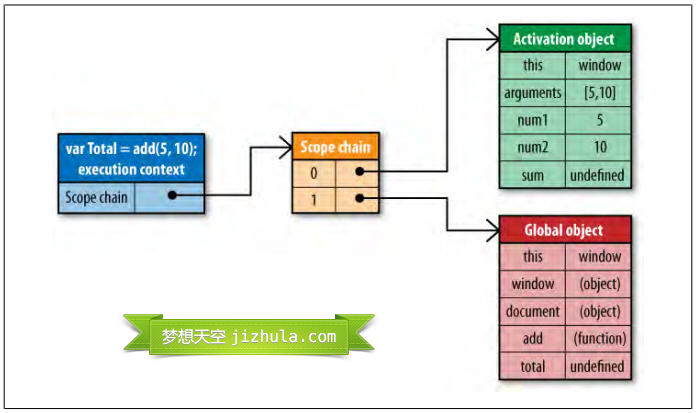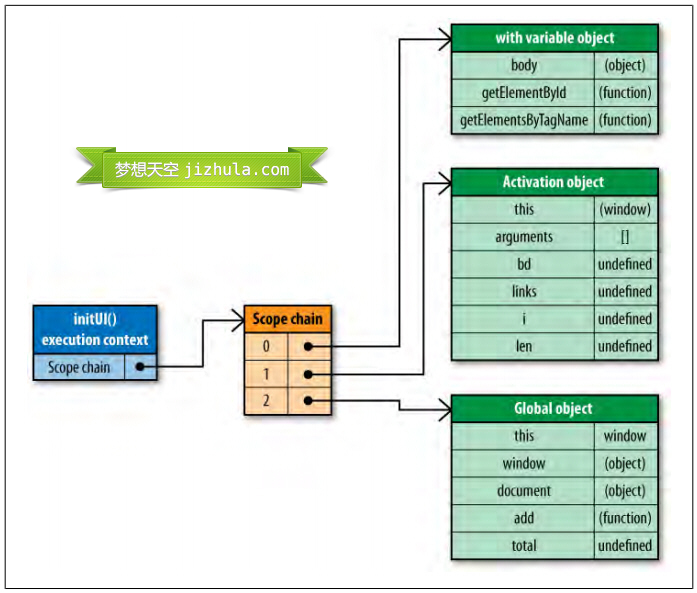Home >Web Front-end >JS Tutorial >In-depth understanding of JavaScript scope and scope chain_javascript skills
In-depth understanding of JavaScript scope and scope chain_javascript skills
- WBOYWBOYWBOYWBOYWBOYWBOYWBOYWBOYWBOYWBOYWBOYWBOYWBOriginal
- 2016-05-16 18:00:43979browse
Scope is one of the most important concepts in JavaScript. If you want to learn JavaScript well, you need to understand how JavaScript scope and scope chains work. Today's article provides a brief introduction to JavaScript scope and scope chain, hoping to help everyone learn JavaScript better.
JavaScript Scope
Any programming language has the concept of scope. Simply put, scope is the accessible range of variables and functions, that is, scope Controls the visibility and life cycle of variables and functions. In JavaScript, there are two types of scopes of variables: global scope and local scope.
1. Global Scope
Objects that can be accessed anywhere in the code have global scope. Generally speaking, the following situations have global scope:
(1) The outermost function and variables defined outside the outermost function have global scope, for example:
var authorName="Mountainside Stream";
function doSomething(){
var blogName="Dream Sky";
function innerSay(){
alert(blogName);
}
innerSay();
}
alert(authorName); //Mountainside creek
alert(blogName); / /Script error
doSomething(); //Dream Sky
innerSay() //Script error
(2) All undefined and directly assigned variables are automatically declared to have global scope , for example:
function doSomething(){
var authorName="Mountainside Stream";
blogName="Dream Sky";
alert(authorName);
}
alert(blogName); //Dream Sky
alert(authorName) ; //Script error
The variable blogName has global scope, and authorName cannot be accessed outside the function.
(3) All properties of the window object have global scope
Generally, the built-in properties of the window object have global scope, such as window.name, window.location, window .top and so on.
1. Local Scope
Contrary to the global scope, the local scope is generally only accessible within a fixed code fragment, the most common such as inside a function, all In some places, you will also see people refer to this scope as function scope. For example, blogName and function innerSay in the following code only have local scope.
function doSomething(){
var blogName=" Dream Sky";
function innerSay(){
alert(blogName);
}
innerSay();
}
alert(blogName); //Script error
innerSay(); //Script error
Scope Chain
In JavaScript, functions are also objects. In fact, everything in JavaScript is an object. Function objects, like other objects, have properties that can be accessed through code and a set of internal properties that are only accessible to the JavaScript engine. One of the internal properties is [[Scope]], defined by the third edition of the ECMA-262 standard. This internal property contains the collection of objects in the scope in which the function is created. This collection is called the scope chain of the function, which determines Which data can be accessed by the function.
When a function is created, its scope chain is populated with data objects accessible from the scope in which the function was created. For example, define a function like the following:
function add(num1, num2) {
var sum = num1 num2;
return sum;
}
When the function add is created, a global object will be filled in its scope chain, The global object contains all global variables, as shown in the figure below (note: the picture only illustrates a part of all variables):

var total = add(5, 10);
The values are copied into the runtime context's scope chain in the order they appear in the function. Together they form a new object called an "activation object". This object contains all the local variables, named parameters, parameter collections and this of the function. Then this object will be pushed to the front end of the scope chain. When the runtime context is destroyed, the active object is also destroyed. The new scope chain is shown below:

Scope chain and code optimization
It can be seen from the structure of the scope chain that in the scope chain of the runtime context, the position of the identifier is higher The deeper it is, the slower the reading and writing speed will be. As shown in the figure above, because global variables always exist at the end of the runtime context scope chain, finding global variables is the slowest during identifier resolution. Therefore, when writing code, you should use global variables as little as possible and use local variables as much as possible. A good rule of thumb is: if a cross-scope object is referenced more than once, store it in a local variable before using it. For example, the following code:
function changeColor(){
document.getElementById("btnChange").onclick=function(){
document.getElementById("targetCanvas").style.backgroundColor="red";
};
}
This function refers to the global variable document twice. To find the variable, you must traverse the entire scope chain until it is finally found in the global object. This code can be rewritten as follows:
function changeColor() {
var doc=document;
doc.getElementById("btnChange").onclick=function(){
doc.getElementById("targetCanvas").style.backgroundColor="red";
};
}
This code is relatively simple and will not show a huge performance improvement after rewriting. However, if there are a large number of global variables in the program that are accessed repeatedly, then rewriting The performance of the resulting code will be significantly improved.
Change the scope chain
The corresponding runtime context is unique each time a function is executed, so calling the same function multiple times will result in the creation of multiple Runtime context, when the function completes execution, the execution context will be destroyed. Each runtime context is associated with a scope chain. Normally, while the runtime context is running, its scope chain will only be affected by with statements and catch statements.
The with statement is a shortcut way to use objects to avoid writing repeated code. For example:
function initUI(){
with( document){
var bd=body,
links=getElementsByTagName("a"),
i=0,
len=links.length;
while(i < len){
update(links[i ]);
}
getElementById("btnInit").onclick=function(){
doSomething();
};
}
}
The width statement is used here to avoid writing the document multiple times, which seems more efficient, but actually causes performance problems.
When the code runs to the with statement, the scope chain of the runtime context is temporarily changed. A new mutable object is created that contains all the properties of the object specified by the parameter. This object will be pushed into the head of the scope chain, which means that all local variables of the function are now in the second scope chain object, and therefore more expensive to access. As shown below:

Another thing that changes the scope chain is the catch statement in the try-catch statement. When an error occurs in the try code block, the execution process jumps to the catch statement, and then the exception object is pushed into a mutable object and placed at the head of the scope. Inside the catch block, all local variables of the function will be placed in the second scope chain object. Sample code:
try{
doSomething();
}catch(ex){
alert(ex.message); //The scope chain changes here
}
Please note that once the catch statement is executed, The scope chain will return to its previous state. The try-catch statement is very useful in code debugging and exception handling, so it is not recommended to avoid it completely. You can reduce the performance impact of catch statements by optimizing your code. A good pattern is to delegate error handling to a function, for example:
try{
doSomething();
}catch(ex){
handleError(ex); //Delegate to the processor method
}
In the optimized code, the handleError method is the only code executed in the catch clause. This function receives an exception object as a parameter, so that you can handle errors more flexibly and uniformly. Since only one statement is executed and no local variables are accessed, temporary changes in the scope chain will not affect code performance.
Related articles
See more- An in-depth analysis of the Bootstrap list group component
- Detailed explanation of JavaScript function currying
- Complete example of JS password generation and strength detection (with demo source code download)
- Angularjs integrates WeChat UI (weui)
- How to quickly switch between Traditional Chinese and Simplified Chinese with JavaScript and the trick for websites to support switching between Simplified and Traditional Chinese_javascript skills

